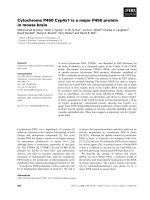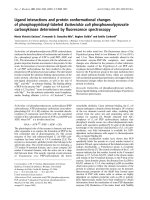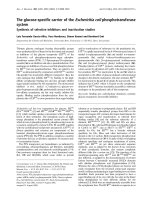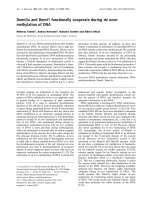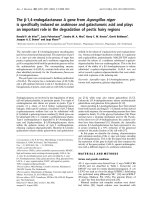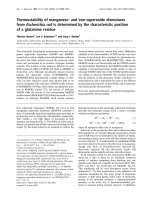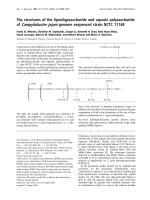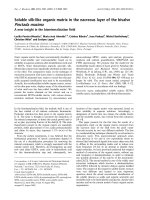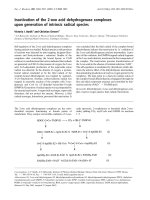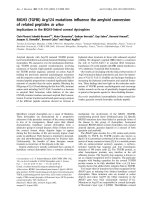Tài liệu Báo cáo Y học: Granule-bound starch synthase I A major enzyme involved in the biogenesis of B-crystallites in starch granules ppt
Bạn đang xem bản rút gọn của tài liệu. Xem và tải ngay bản đầy đủ của tài liệu tại đây (454.76 KB, 11 trang )
Granule-bound starch synthase I
A major enzyme involved in the biogenesis of B-crystallites in starch granules
Fabrice Wattebled
1
, Alain Bule
´
on
2
, Brigitte Bouchet
2
, Jean-Philippe Ral
1
, Luc Lie
´
nard
1
, David Delvalle
´
1
,
Kim Binderup
1
, David Dauville
´
e
1
, Steven Ball
1
and Christophe D’Hulst
1
1
Unite
´
de Glycobiologie Structurale et Fonctionnelle, Unite
´
Mixte de Recherche CNRS/USTL n°8576, Unite
´
Sous Contrat de l’INRA,
Universite
´
des Sciences et Technologies de Lille, Villeneuve d’Ascq, France;
2
Institut National de la Recherche Agronomique,
Centre de Recherches Agroalimentaires, Nantes, France
Starch defines a semicrystalline polymer made of two
different polysaccharide fractions. The A- and B-type
crystalline lattices define the distinct structures reported in
cereal and tuber starches, respectively. Amylopectin, the
major fraction of starch, is thought to be chiefly respon-
sible for this semicrystalline organization while amylose is
generally considered as an amorphous polymer with little
or no impact on the overall crystalline organization. STA2
represents a Chlamydomonas reinhardtii gene required for
both amylose biosynthesis and the presence of significant
granule-bound starch synthase I (GBSSI) activity. We
show that this locus encodes a 69 kDa starch synthase
and report the organization of the corresponding STA2
locus. This enzyme displays a specific activity an order of
magnitude higher than those reported for most vascular
plants. This property enables us to report a detailed
characterization of amylose synthesis both in vivo and
in vitro. We show that GBSSI is capable of synthesizing a
significant number of crystalline structures within starch.
Quantifications of amount and type of crystals synthesized
under these conditions show that GBSSI induces the
formation of B-type crystals either in close association
with pre-existing amorphous amylopectin or by crystalli-
zation of entirely de novo synthesized material.
Keywords: starch; amylose synthesis; granule-bound starch
synthase; Chlamydomonas reinhardtii; in vitro synthesis.
Starch accumulates in plants as a complex granular
mixture of a-glucans (a-1,4-linked and a-1,6-branched)
consisting chiefly of amylopectin and amylose. In amylo-
pectin, the major fraction is composed of small-size a-1,4-
linked chains that are clustered together by the presence of
5% a-1,6 linkages [1] (starch structure reviewed in [2] and
[3]; starch metabolism reviewed in [4]). Amylose is
composed of longer chains with less than 1% a-1,6
branches. Plant starch can be further distinguished from
glycogen by the presence of highly ordered parallel arrays
of double helical glucans (reviewed in [5]). The origin of
these arrays resides in the close packing of the a-1,6
linkages at the root of the unit amylopectin cluster. The
9 nm size of each repetitive unit or cluster is conserved
throughout the plant kingdom [6]. Two major types of
crystalline organization have been documented so far in
native starch granules. A-type powder diffraction patterns
can be recovered from most cereal endosperm and
Chlamydomonas reinhardtii starches while B-type struc-
tures were reported for tuber starches or high amylose
starches from mutants of algae and cereals. It is generally
assumed that amylopectin plays a major role in establish-
ing the crystalline organization of starch. Indeed, amylose-
defective mutants or antisense constructs of maize and
potato accumulate normal amounts of starch with the
same A- or B-type granule organization and similar
crystallinities to the corresponding wild-type references. In
addition, starches with elevated amylose content are
generally less crystalline suggesting that most, if not all,
of the amylose remains amorphous within the granule.
Amylose synthesis has been known since the foundation
work laid by Nelson & Rines [7], to depend on the
presence of granule-bound starch synthase I (GBSSI), an
enzyme identified by de Fekete et al.[8],asassociatedwith
starch granules. GBSSI was first reported to use non-
physiological concentrations of UDP-glucose [9] while
ADP-glucose was shortly discovered thereafter as the
preferred donor substrate [10]. Mutations leading to
defectsforGBSSIhavebeenisolatedinanever-increasing
number of species including waxy (wx) maize [11], wx rice
[12], wx barley [13], wx wheat [14], amylose-free (amf)
potato [15], low amylose (lam) pea [16], wx amaranth [17]
and sta2 C. reinhardtii [18]. A number of studies
approaching the synthesis of amylose in vitro [9,19–21],
Correspondence to C. D’Hulst, Unite
´
de Glycobiologie
Structurale et Fonctionnelle, Unite
´
Mixte de Recherche
CNRS/USTL n°8576, Unite
´
Sous Contrat de l’INRA,
Universite
´
des Sciences et Technologies de Lille, 59655 Villeneuve
d’Ascq, Cedex France.
Fax: + 33 3 20436555, Tel.: + 33 3 20434881,
E-mail:
Abbreviations: GBSSI, granule-bound starch synthase I; RFLP,
restriction fragment length polymorphism.
Enzymes: soluble and granule-bound starch synthases:
ADPglucose:1,4-a-
D
-glucan 4-a-
D
-glucosyltransferases (EC 2.4.1.21);
ADP-glucose pyrophosphorylase: ADP:a-
D
-glucose-1-phosphate
adenylyltransferase (EC 2.7.7.27).
Note: a web site is available at />(Received 11 January 2002, revised 21 June 2002,
accepted 25 June 2002)
Eur. J. Biochem. 269, 3810–3820 (2002) Ó FEBS 2002 doi:10.1046/j.1432-1033.2002.03072.x
establish that GBSSI incorporates glucose both in amy-
lopectin and amylose according to the conditions used.
Leloir et al. [9] originally noted a stimulation of GBSSI by
high concentrations of malto-oligosaccharides and found
incorporation of radioactive glucose into both starch
fractions. In a recent study, Denyer et al. [21] showed that
in the absence of these oligosaccharides, the labelled
product synthesized in vitro by GBSSI was confined to the
amylopectin fraction. However in the presence of high
malto-oligosaccharide concentrations, GBSSI incorporated
glucose massively into amylose-like glucans. In vivo
evidence supporting the involvement of GBSSI in amylo-
pectin synthesis was produced in Chlamydomonas by
Maddelein et al. [22]. Additional in vitro synthesis experi-
ments performed with starch granules isolated from
C. reinhardtii show that amylose synthesis can occur in
the absence of malto-oligosaccharide priming by extension
and cleavage of a nonreducing end available on an
amylopectin molecule [23]. It has recently been shown that
thismechanismalsoappearstobeatworkinthestarches
extracted from higher plants [24]. However the total
amount of GBSSI activity measured in Chlamydomonas
starch appeared 10- to 50-fold higher than that measured
in vascular plant starches [24].
We now report the cloning and characterization of
cDNAs and gDNAs corresponding to a granule-bound
starch synthase from C. reinhardtii. We show that this
sequence corresponds to the previously characterized STA2
gene required for amylose synthesis. We show that this
69 kDa enzyme contains an extra 11.4 kDa at the
C-terminus that is not found in the higher plant enzymes.
Detailed in vivo investigationsperformed during the course of
storage starch synthesis show that amylopectin and amylose
synthesis are partly disconnected and that amylose synthesis
persists when the rate of polysaccharide and amylopectin
synthesis become minimal.Invitrosynthesis experiments
performed using wild-type Chlamydomonas starch with this
high specific activity enzyme establish that GBSSI induces
the formation of B-type crystalline structures.
EXPERIMENTAL PROCEDURES
Materials
ADP[U-
14
C]glucose and a[
32
P]dCTP were purchased from
Amersham (Amersham, Buckinghamshire, UK). ADP-
glucose was obtained from Sigma. CL-2B SepharoseÒ
column and PercollÒ were obtained from Amersham
Pharmacia Biotech. Starch assay kit was obtained from
Roche (Germany).
Chlamydomonas
strains, growth conditions and media
The reference strains of C. reinhardtii used in this study are
137C (mt-nit1 nit2)and330(mt+ nit1 nit2 arg7-7 cw15).
CS9 (mt+) is a wild-type strain of Chlamydomonas smithii.
Both C. smithii and C. reinhardtii are interfertile ecotypes
that give rise to a fertile progeny. The GBSSI-defective strain
BAFR1 (mt+ nit1 nit2 sta2–29::ARG7) contains a disrup-
tion of the STA2 gene that was generated through random
integration of the pARG7 plasmid in the nuclear DNA of
C. reinhardtii [18]. Strain IJ2 has been already described
elsewhere [22] and contains mutations at both the STA2 and
STA3 loci. Mutation in the latter leads to the complete
disappearance of the major soluble starch synthase enzyme.
Strain 18B (mt-nit1 nit2 sta2-1) displays a mutation at the
STA2 locus which leads to synthesis of a truncated GBSSI
(58 kDa) [18]. The adequate strain for phenotypic comple-
mentation is TERBD20 (sta2-1nit1nit2cw15arg7-7)andis
a descendant from a cross involving strains 330 and 18B.
Finally, strain I7 has been described by van den Koornhuyse
et al. [25] and carries a mutation at locus STA1 encoding the
small subunit of ADP-glucose pyrophosphorylase. I7 accu-
mulates less than 5% of normal starch quantity. Standard
media are fully detailed in [26] while growth conditions and
nitrogen-starved media are described in [18,27–29].
Determination of starch levels, starch purification and
spectral properties of the iodine–starch complex
A full account of amyloglucosidase assays, starch purifica-
tion on Percoll gradients, starch granule-bound proteins
solubilization and k
max
(maximal absorbance wavelength of
the iodine polysaccharide complex) measures can be found
in [18].
In vitro
synthesis of amylose
Starch (13.9 mg) was incubated with 3.2 m
M
ADP-
glucose in the presence of 50 m
M
glycine (pH 9.0),
100 m
M
(NH
4
)
2
SO
4
, 0.4% 2-mercaptoethanol, 5 m
M
MgCl
2
and 0.05% BSA in a total volume of 52 mL at
30 °C for 4, 14, 24 and 48 h incubation and in a total
volume of 78 mL for 72 h incubation. After incubation,
the suspension was centrifuged at 4000 g for 10 min and
the supernatant discarded. The starch pellet was then
washed three times in 50 mL of sterile milliQ water. After
the last wash, the starch pellet was stored at 4 °C
awaiting further analysis.
Separation of starch polysaccharides by gel permeation
chromatography
Starch (0.5–1.0 mg) dissolved in 10 m
M
NaOH (500 lL)
was applied to a column (0.5 cm internal diameter · 65 cm)
of Sepharose CL-2BÒ, which was equilibrated and eluted
with 10 m
M
NaOH. Fractions of 300–320 lL were collected
at a rate of one fraction per 1.5 min. Glucans in the
fractions were detected by their reaction with iodine and the
levels of amylopectin and amylose were determined by
amyloglucosidase assays (Roche).
In vitro
assay of GBSSI activity
This assay is fully described in both [18] and [22]. Briefly,
50 lg of fresh starch granules were incubated at 30 °Cfor
30 min in 100 lL of the following buffer: Glygly (NaOH),
pH 9, 50 m
M
;(NH
4
)
2
SO
4
,100m
M
; 2-mercaptoethanol,
5m
M
;MgCl
2
,5m
M
;BSA,0.25gÆL
)1
;ADP-glucose
3.2 m
M
;and[U
14
C]ADP-glucose (336 mCiÆm
M
)1
),
0.75 n
M
. The reaction was stopped by addition of 2 mL
of 70% ethanol. The resulting precipitate was subsequently
filtered on a glass-fibre filter (Whatmann GF/CÒ), rinsed
with 15 mL of 70% ethanol, dried for 30 min at room
temperature and finally counted in a liquid scintillation
counter.
Ó FEBS 2002 In vitro synthesis of amylose (Eur. J. Biochem. 269) 3811
Antibodies directed against whole starch-bound
proteins: Western blots
To produce antisera raised against whole starch-bound
proteins, native starch granules purified from strains IJ2 and
137C were applied to rabbits (New Zealand albinos) in three
successive intramuscular injections of 20 mg spaced by
3 weeks. Before injection, one volume of complete Freund
adjuvant (Difco, Detroit, MI, USA) was added to the
starch-granule suspension. Antisera were then prepared
from 20 to 50 mL of blood from immunized rabbit. After
blood coagulation, clots were removed by centrifugation at
13 000 g for 15 min at 4 °C and the resulting supernatant
(antiserum) was subsequently aliquoted into 1-mL samples
and could be kept at )80 °C for several months.
Proteins bound to the starch granule were separated by
electrophoresis on classical SDS/PAGE gel (7.5% acryl-
amide and 0.1% SDS; methods to extract starch granule-
bound proteins are fully described in [18]). Before blotting
proteins onto nitrocellulose membrane (Protean BAÒ,
Schleicher & Schuell), the gels were incubated for 15 min
in a Western blot buffer [48 m
M
Tris, 39 m
M
glycine,
0.0375% (w/v) SDS and 20% methanol]. The transfer was
carried out using the Mini Trans-Blot Cell (Biorad,
Hercules, CA, USA) for 45 min at 250 mA with the same
Western blot buffer. After blocking for 4 h in a 3% BSA
solution made in Tris/NaCl/Tween buffer (Tris base,
20 m
M
; NaCl, 137 m
M
;0.1%Tween20;pH7.6with1
M
HCl), membranes were incubated overnight at 4 °Cwiththe
specific antiserum diluted in Tris/NaCl buffer (Tris base,
20 m
M
; NaCl, 137 m
M
;pH7.6with1
M
HCl). After
incubation, membranes were rinsed several times in Tris/
NaCl/Tween buffer at room temperature before immuno-
detection with a biotin and streptavidin/alkaline phospha-
tase kit (Sigma) following the supplier’s instructions.
Cloning of the full-length GBSSI cDNA
A partial cDNA clone corresponding to algal GBSSI was
isolated as follows. Approximately 500 000 lysis plaques of
a Chlamydomonas kZAP II cDNA library were screened
with antisera SA137C and PA55 as described by Sambrook
et al. [30]. A cDNA clone (named CD142) with an insert of
1696 bp was isolated and fully sequenced on both strands
and submitted to GenBank (accession number AF026420).
To obtain more information about the 5¢ end of this cDNA,
an RT-PCR amplification was done using a specific primer
5¢-CGCAAACACCTCGCTGGCAC and a degenerated
primer 5¢-AAGACSGGYGGYCT corresponding to the
highly conserved KTGGL sequence found at the
N-terminal part of all GBSSIs cloned to date. An amplified
fragment of 1380 bp (named CD142#A) was cloned in
pBluescriptII SK+ and fully sequenced on both strands. To
obtain the 5¢ end of the GBSSI cDNA a RACE-PCR
protocol was used (Life Technologies) following the suppli-
er’s instructions. A total fraction of RNA from the wild-
type strain was reverse transcribed using the specific primer
5¢-CACGCGGGCAGCCTCAATAG. A first PCR ampli-
fication of the subsequently produced cDNA was done
using the specific primer 5¢-CGAAGCGCTTGTGG
TTGTC while the nested PCR amplification was carried
out with the following specific primer 5¢-CGTAGC
GAGGGGCAATGGTC. The complete cDNA obtained
was submitted to GenBank under the same previous
accession number (AF026420). Total RNA was extracted
from the wild-type strain 330 with RNeasy Plant Mini Kit
(Qiagen) following the supplier’s instructions.
Cloning of the full-length GBSSI gDNA
To isolate a genomic copy of the structural gene of
Chlamydomonas GBSSI, 11280 Escherichia coli clones from
a cosmid library [31] were screened using the CD142 insert
as a radiolabelled probe. This genomic library is indexed in
120 microtitration plates and the corresponding E. coli
clones were transferred onto nylon filters and consequently
treated as described by Sambrook et al.[30]beforehybrid-
ization with the specific nucleotide probe. From a total of 16
positives clones, three were selected for further analysis
because of their strong hybridization with probe CD142
(GB911, GB1114 and GB1411). Only GB911 gave pheno-
typic complementation of the sta2-1 mutant strain (see
Results). This prompted us to use this cosmid for complete
sequencing of the STA2 gene.
Complementation of the sta2-1 mutation
Strain TERBD20 was cotransformed with both GB911
cosmid clone and the plasmid pASL [32]. Approximately
10
8
cells were transformed by the glass bead method with
1 lgofpASLmixedwith4lg of cosmid GB911 as
described by Kindle et al. [33]. Transformant clones were
selected and purified on minimal medium (high salt acetate)
prior to their analysis.
Restriction fragment length polymorphism (RFLP) analysis
Standard protocols for molecular biology as described by
Sambrook et al. [30] were used for RFLP analysis, including
gDNA restriction and subsequent electrophoresis on aga-
rose gel, transfer onto nylon membranes and hybridization
with a specific probe. Chlamydomonas gDNA was prepared
as described in [34]. Approximately 10 lg of gDNA was
digested with 50 units of restriction enzyme. Restriction
fragments were then separated on 0.8% agarose gel and
transferred onto a nylon membrane (Porablot, NY Amp,
Macherey-Nagel). Hybridization was performed overnight
at 65 °C in the following hybridization buffer: 5 · NaCl/
Cit, 5 · Denhardt’s, 0.1% SDS, 0.1 gÆmL
)1
denatured
salmon sperm DNA where 1 · NaCl/Cit is 0.15
M
NaCl,
0.015
M
sodium citrate and 1 · Denhardt’s is 0.2 gÆL
)1
Ficoll 400, 0.2 gÆL
)1
PVP40 and 0.2 gÆL
)1
BSA. Probes
were radiolabelled by random primers method as described
by supplier’s instruction (Amersham Life Science). Mem-
branes were typically washed twice in 2 · NaCl/Cit, 0.1%
SDS at 65 °C for 10 min and twice in 0.5 · NaCl/Cit, 0.1%
SDS at 65 °C for 10 min before exposure to X-ray film.
Scanning electron microscopy
Scanning electron microscopy experiments were performed
as already described in [35]. Starch granules were stuck onto
brass stubs with double-sided carbon-conductive adhesive
tape and covered with a 30 nm gold layer using an 1100 ion-
sputtering device (Jeol). Samples were then examined with a
840-A scanning electron microscope (Jeol) operating at an
3812 F. Wattebled et al. (Eur. J. Biochem. 269) Ó FEBS 2002
accelerating voltage of 5 keV with a current probe of 0.1
nA. The working distance was 15 mm.
X-ray diffraction measurements
Samples (10 mg) were sealed between two aluminium foils
to prevent any significant change in water content during
the measurement. Diffraction diagrams were recorded using
Inel (Orleans, France) X-ray equipment operating at 40 kV
and 30 mA. CuK
a1
radiation (k ¼ 0.15405 nm) was select-
ed using a quartz monochromator. A curved position-
sensitive detector (Inel CPS120) was used to monitor the
diffracted intensities using 2 h exposure periods. Relative
crystallinity was determined, after bringing all recorded
diagrams to the same scale using normalization of the total
scattering between 3° and 30° (2h) following a method
derived from Wakelin et al. [36]. Dry extruded starch and
spherolitic crystals of amylose were used as amorphous and
crystalline standards, respectively.
RESULTS
Molecular cloning of cDNA encoding a protein
recognized by an antibody directed against
granule-associated proteins
Starch was purified from nitrogen-supplied cultures of both
the wild-type 137C reference and a mutant strain carrying a
gene disruption in the STA2 locus of C. reinhardtii (strain
IJ2). This sta2-29::ARG7 mutation induces the simulta-
neous loss of GBSSI activity and of the major protein
associated with starch. The latter migrates as a 76 kDa band
on SDS/PAGE gels [18]. The sta2-1 mutation was previ-
ously described as leading to the production of a truncated
58 kDa GBSSI protein. Microsequencing of both sta2-1
and wild-type GBSSI have shown that both N-termini were
strictly identical [18]. Moreover, several mass spectrometry
analyses recently conducted on mutant and wild-type
proteins showed the specific disappearance of C-terminal
peptides in the truncated protein. Whereas all peptides
upstream of the sequence EGLLEEV VYGKG (positions
502–513 on the mature protein) are present in both proteins,
peptides downstream of the sequence IPGDLPA
VSYAPNTLKPVSASVEGNGAAAPK (positions 531–
561) are selectively absent in the sta2-1 mutant polypeptide.
The absence of the C-terminal tail in sta2-1 mutants
correlates with an increase in the ADP-glucose K
m
from 4 to
over 20 m
M
ADP-glucose [18].
Whole wild-type native starch granules were injected
intramuscularly into rabbits (to give a total of 60 mg).
Antisera were prepared from these animals as detailed in
Experimental procedures. These antisera were analysed by
Western blotting against starch-bound proteins isolated
from the aforementioned wild-type and mutant Chlamydo-
monas strains. The blots gave results identical to those
generated by the PA55 antibody directed against a synthetic
peptide conserved at the C-terminal of all starch synthases
examined to date [37]. This prompted us to use both the
PA55 and the SA137C antibodies to screen for expression of
corresponding epitopes within a k ZAP II cDNA library.
From a total of 25, we found one and four phage plaques
reacting against PA55 and SA137C, respectively, and their
sequences showed high similarities to GBSSI already cloned
in higher plants. These sequences covered a total of 1696 bp
an were deposited in GenBank as CD142 (accession number
AF026420).
Characterization of the GBSSI cDNA sequences
To obtain additional GBSSI sequences, we used RT-PCR
and amplified a 1380-bp fragment that covers the
N-terminal part of the protein. This was performed by
selecting oligonucleotide primers derived from the con-
served KTGGL sequence found towards the N-terminus of
all GBSSI proteins studied to date. Finally, to generate the
full GBSSI cDNA sequence we used RACE-PCR (as
described in Experimental procedures) to generate an
additional fragment of 435 bp. Three independent RACE-
PCR experiments were performed in order to determine the
+1 nucleotide for transcription. N-Terminal sequencing of
the GBSSI protein solubilized from wild-type granules [18]
established the transit peptide cleavage site at position 57.
The full GBSSI protein contains an extra 11.4 kDa
C-terminal tail with no significant homology to any
previously published starch or glycogen-synthase sequence.
The predicted mass of the mature protein appeared to be
7 kDa smaller than that inferred by the SDS/PAGE
measurements (i.e. 69 and not 76 kDa). The sequence
comparisons displayed in Fig. 1 using the
CLUSTALW
method with PAM (percent accepted mutation) series
residue weight matrix (gap penalty ¼ 10; gap length penalty
¼ 0.2) have enabled us to build the phylogenetic tree shown
in Fig. 2. It is clear from this analysis that divergence of
GBSSI sequences found by comparing several plant species
occurred at a very early stage during the evolution of
photosynthetic eukaryotes.
Characterization of the GBSSI gDNA sequences
The cDNA clone CD142 was used to select for correspond-
ing gDNAs from an indexed cosmid library [31]. A 6.5 kb
fragment in cosmid GB911 covering most of the GBSSI
coding sequences was subcloned in two overlapping parts of
3.0 and 4.5 kb and subjected to DNA sequencing thus
generating a 5856 bp gDNA sequence deposited in Gen-
Bank (accession number AF433156). Figure 3 displays the
length and position of the six introns within the GBSSI
sequence compared with those of rice and potato. The
number and position of the introns are unrelated to those
present in vascular plant genes and suggest an ancient
divergence of the GBSSI gene in green algae.
Establishing the nature of the STA2 locus
Two separate lines of evidence show that the cDNA and
gDNA clones correspond to the STA2 gene products. First,
a gDNA clone obtained in an indexed cosmid library [31]
complemented a sta2-1 mutation. Figure 4 shows the
various levels of phenotypic complementation obtained
with six independent transformants. GBSSI specific activ-
ities (calculated with respect to the quantity of Chlamydo-
monas starch involved in the assay) in the complemented
strains varied from 44 to 84% when compared with that of
the wild-type strain. It is clear that six strains (out of three
hundred) cotransformed with the GB911 gDNA restored
both amylose biosynthesis (at least partially) and the
Ó FEBS 2002 In vitro synthesis of amylose (Eur. J. Biochem. 269) 3813
presence of the 69 kDa GBSSI protein (data not shown).
Restoration of amylose synthesis is likely to come as a
consequence of the random integration of the wild-type
STA2 gene in the nuclear genome of Chlamydomonas.
Nevertheless, depending on the integration site, expression
of this integrated wild-type copy of STA2 might vary
greatly. Indeed integrations in some genomic regions have
been reported to trigger silencing of the DNA introduced
[38–40]. These Ôposition effectsÕ could therefore explain
variation in phenotype between transformants and only
partial restoration of amylose synthesis. It must be stressed
that in control experiments involving cotransformation with
randomly selected cosmids we never observed complemen-
tation of the sta2 mutations.
Second, the CD142 cDNA was used to find RFLPs in
strains disrupted for the STA2 gene (Fig. 5). We were able
to show that these differences cosegregated in 22 indepen-
dent meiotic recombinants in a cross involving strain IJ2
(sta2-29::ARG7 sta3-1) and an interfertile ecotype of
C. reinhardtii known as C. smithii (strain CS9). This latter
is wild-type regarding starch accumulation. Functional
complementation of sta2-1 mutation by the gDNA
sequence together with the demonstration of allele-specific
changes in this gDNA by particular STA2 mutations
demonstrates that the cloned gene defines STA2 and that
the latter encodes GBSSI.
Amylose in storage starch appears after a block
in amylopectin synthesis
Nitrogen starvation in Chlamydomonas offers a good
model with which to understand the basic physiology of
storage starch synthesis. During nitrogen starvation cellu-
lar components including thylakoid membranes are bro-
ken down and converted into both lipid droplets and
starch. We followed the kinetics of amylose synthesis over
a 5-day period of nitrogen starvation and measured the
amounts of starch, amylose, the k
max
of the starch
fractions, the degree of crystallinity and the X-ray
Fig. 2. Phylogenetic tree established from GBSSI proteins sequences
alignment as shown in Fig. 1.
Fig. 1. Peptide sequence comparison of Chlamydomonas GBSSI with those of other plant species. This analysis was done using mature proteins only.
Alignment was generated using the
CLUSTALW
method with PAM series residue weight matrix (gap penalty ¼ 10; gap-length penalty ¼ 0.2).
Residues matching the consensus GBSSI sequence derived from this comparison are shaded in black. Accession numbers for the different GBSSI
are as follows: wheat: P27736; Chlamydomonas: AF026420; maize: P04713; pea: X88789; rice: P19395; barley: X07931; potato: X58453.
3814 F. Wattebled et al. (Eur. J. Biochem. 269) Ó FEBS 2002
diffraction type. The granule morphology was also
followed by scanning electron microscopy and transmis-
sion electron microscopy of slices of starch granules
stained by Patag (data not shown). The results listed in
Table 1 show that for the first 12 h the cells are actively
engaged in amylopectin synthesis and that the overall rate
of polysaccharide synthesis decreases strongly thereafter.
The small amounts of transitory starch amylose present at
t ¼ 0 and after 12 h do not allow us to measure
significant rates of amylose synthesis and we can only
state that the latter certainly does not exceed the rate of
amylopectin synthesis. The increase in crystallinity wit-
nessed during these first 12 h is in line with the high rates
observed for amylopectin synthesis. However between 12
and 58 h the rate of amylose synthesis becomes significant.
After an additional 63 h, the rate of polysaccharide
synthesis decreases further and the rate of amylose
synthesis accounts for most polysaccharide synthesis. At
this stage the rate of amylopectin synthesis has become
minimal and it is difficult to say if the residual
amylopectin synthesis activity is due to a residual soluble
starch synthase activity or to the previously described
Fig. 4. Iodine staining of Chlamydomonas cell patches. Cells were grown under nitrogen starvation for 7 days under continuous light and were
subsequently stained with iodine vapours. T indicates the untransformed reference strain (TERBD20: sta2-1) whereas C, D, G, L, M, N and P
indicate independent strains derived from TERBD20 transformed with cosmid GB911. The T strain, devoid of amylose, displays a typical red
iodine stain. Stains of others strains result from various levels of phenotypic complementation indicating, in most cases (except for strain N), a
partial restoration of amylose biosynthesis within the cells. Strains C, D, G and P show, respectively, 84%, 58%, 44% and 81% of wild-type GBSSI
activity as determined by in vitro incubation (not determined for strains L and M).
Fig. 3. Introns/exons organizations comparison of three different GBSSI genes including Chlamydomonas reinhardtii (A; accession number
AF433156), Solanum tuberosum (B; accession number: X58453) and Oryza s ativa (C; accession number: AF141955).
Ó FEBS 2002 In vitro synthesis of amylose (Eur. J. Biochem. 269) 3815
ability of GBSSI to extend amylopectin outer chains.
Again this coincides with a decrease in crystallinity. This
situation closely mimics that which was reported for cereal
endosperm storage starch where amylose continues to
accumulate at the final stage of starch synthesis in the
absence of concomitant amylopectin synthesis (reviewed in
[41]).
In vitro
synthesis of amylose
Because in Chlamydomonas amylose synthesis remains
active when amylopectin synthesis has become minimal,
wehavedecidedtoresorttoasemiin vitro system that
contains all the native enzymes and structures required for
amylose synthesis but lacks the amylopectin synthesis
machinery. This system consists of intact starch granules
purified from Chlamydomonas strains under physiological
conditions where the synthesis of amylose has remained
minimal. These conditions are defined either by wild-type
log phase growing Chlamydomonas cultures or by growth-
arrested (nitrogen-starved) cultures where the synthesis of
ADP-glucose has been lowered through a mutation in the
ADP-glucose pyrophosphorylase large subunit structural
gene. These granules are packed with wild-type GBSSI
protein, contain less than 2% amylose and display a starch
structure identical to that defined at the start of the in vivo
experiment described above. We had previously used this
system to demonstrate that the Chlamydomonas GBSSI
Fig. 5. Southern blot analysis of sta2-29::ARG7 (indicated as sta2-D1) mutant and wild-type strains. Molecular hybridization was carried out with
probe CD142 previously radiolabelled with a[
32
P]dCTP. Prior to migration on 0.8% agarose gel, gDNA was subjected to restriction with SpeI for
4hat37°C. Whereas all STA2 strains display a 4.0 kb band that specifically hybridizes with probe CD142, all sta2–29::ARG7 mutant strains lack
this band. 137C and CS9 are wild-type strains from Chlamydomonas reinhardtii and Chlamydomonas smithii ecotypes, respectively. IJ2 is the
parental strain mutant for both STA2 and STA3 genes. Lanes 4–16 and 21–29 correspond to independent recombinant strains obtained from a
cross involving CS9 and IJ2 parental strains.
Table 1. Kinetics of in vivo synthesis of amylose. In order to induce massive polysaccharides biosynthesis, Chlamydomonas cells were transferred
from ammonium-supplied medium to nitrogen-free medium at t ¼ 0 h. The resulting production of starch was followed over a 5-day period.
Amylose percentage of starch weight was measured (amyloglucosidase assay; Roche) after gel filtration chromatography on a Sepharose CL-2BÒ
column of starch dispersed in 10 m
M
NaOH. Crystallinity levels were measured for total starch. NA, not applicable.
Time of
culture
(h)
Total starch
in 10
)6
cells
(lg)
k
max
of total
starch (nm
a
) % of amylose
%of
crystallinity
(± 3%)
Amylose
synthesis
rate (lgÆh
)1
)
Amylopectin
synthesis rate
(lgÆh
)1
)
0 2.1 563 < 2
b
25 NA
–
12 13.4 563 < 2
b
35 NA 942
48 15.8 572 3.6 34 16 51
58 23 574 10.3 32 180 540
121 26 590 15.3 27 25.5 22
a
k
max
is the wavelength at the maximal absorbance of iodine–polysaccharide complex.
b
< 2% represents the sensitivity of the starch
fractionation technique.
3816 F. Wattebled et al. (Eur. J. Biochem. 269) Ó FEBS 2002
readily synthesizes amylose in vitro by extending amylopec-
tin chains and subsequently releasing these glucans after
cleavage [23]. GBSSI from vascular plants behaved in a
similar fashion [24]. However most vascular plant enzymes
displayed 10- to 50-fold lower specific activities with respect
to starch when assayed in comparison with Chlamydomonas
GBSSI in the same set of experiments. Because of this high
activity, we were able to double the amount of polysac-
charide by a 24 h incubation of purified starch granules in
the presence of 3.2 m
M
ADP-glucose. We thus used these
conditions to investigate the consequences of amylose
synthesis on granule organization and more specifically on
starch crystallinity. STA2 gene disruptions do not yield any
measurable glucose residue incorporation under these
conditions and the observed synthesis is therefore solely
under GBSSI control. In our previous studies, we docu-
mented a switch from A- to B-type diffraction patterns after
in vitro synthesis of amylose in the presence of 3.2 m
M
ADP-
glucose. However the low amounts of starch analyzed
allowed neither precise quantification of crystallinity levels
nor determination of the ratio between the A- and the
B-type structures amongst the crystals. We resolved to
readdress this issue and to probe quantitatively the conse-
quences of GBSSI action on granule crystallinity and
morphology. The results listed in Table 2 show that GBSSI-
mediated synthesis is able to lead to the appearance of a
significant amount of crystalline material. The granules used
for this analysis were extracted from nitrogen-supplied
Chlamydomonas cultures and are similar to the transitory
starch found in plant leaves. Before incubation with ADP-
glucose this polysaccharide displays a high crystallinity of
the A-type with few B-type crystals present. After a mere
24 h, crystallinity has decreased from 42 to 32% whilst
B-type crystals have increased from 7 ± 5% of the
crystalline material to 33 ± 5%, switching the whole
pattern to what is generally defined as B-type starch.
Table 2 shows that during the whole process the amount of
A-type crystals stays remarkably constant, strongly sug-
gesting that preformed A-type crystals from amylopectin
are neither concerned with nor altered by the process of
amylose synthesis. However the total amount of B-type
crystal increases from 409 lgtoover2000lg and accounts
for up to 33% of the newly synthesized material. This
strongly suggests that GBSSI induces de novo formation of
B-type crystals and does not switch preformed A-type into
B-type crystals. The results are consistent with either the
crystallization of GBSSI-synthesized material into B-type
crystals or the conversion of amorphous amylopectin into
crystalline B-type material. Sepharose CL-2BÒ gel filtration
chromatography analysis performed on each sample after
incubation (Fig. 6) show standard patterns of elution while
amylose content goes up with time of incubation as
witnessed by the increase in absorbance. Finally we
examined the impact of massive amylose synthesis on
granule morphology (Fig. 7). The transitory starch granules
appear smooth, rounded and clearly separated at t ¼ 0 while
the starches subjected to 24 h in vitro synthesis of amylose
appear highly distorted and partly fused into a network.
This demonstrates that at least part of the synthesis can
occur at the surface of the granule. The apparent polarized
growth of the granules is consistent with either an aniso-
tropic distribution of GBSSI or a filling of the amorphous
regions of the granule leading to random distortions and
subsequent polarized growth.
DISCUSSION
This work reports the molecular cloning and characteriza-
tion of both the complete cDNA and gDNA of C. reinhardtii
encoding GBSSI, the enzyme responsible for amylose
biosynthesis in plants. A major difference between the algae
and vascular plants consists of the presence of an extra
11.4 kDa at the C-terminus of the mature algal enzyme.
When the specific activities (activity vs. amount of starch)
were measured in comparison with potato, cassava, taro and
wheat, the Chlamydomonas enzyme appeared at least 10-fold
more active than the most active plant enzymes. However
starch did not seem to be selectively enriched in GBSSI
protein. The difference in activities can thus be attributed to
the difference in starch structure, granule size distribution
and (or) to a more active GBSSI protein per se.Whetherthe
extra C-terminal 11.4 kDa are responsible for increasing the
GBSSI activity remains to be demonstrated. Despite several
attempts, no significant homology to any already known
protein or Ôprotein domainÕ could be drawn from sequence
comparison driven by this 11.4 kDa extension itself. Never-
theless this extension seems to be required for full activity of
GBSSI because the sta2-1 mutant allele that leads to the
absence of amylose in the corresponding strain completely
lacks this 11.4 kDa extension. This increase in activity
enabled us to nearly double the amount of polysaccharide in
24 h upon incubation of purified starch granule in the
Table 2. In vitro synthesis of amylose. Initial starch (13.9 mg) was subjected to in vitro synthesis in the presence of ADP-glucose at 3.2 m
M
at 30 °C
under continuous shaking in a total volume of 52 mL for the following incubation times: t ¼ 4, 14 and 24 h. Amylopectin (second column) and
amylose (third column) percentages of starch weight were determined after gel filtration chromatography on a Sepharose CL-2BÒ column of starch
dispersed in 10 m
M
NaOH. Crystallinity levels (last three columns) were measured for total starch submitted to in vitro synthesis.
Time of
incubation
(h)
a
Total starch
(mg) % Amylopectin % Amylose
% of A-type
crystals (± 5%)
% of B-type
crystals (± 5%)
% of total
crystallinity
(± 3%)
0 13.9 87 13 93 7 42
4 20.6 69 31 67 33 34
14 22.9 59 41 67 33 34
24 22.5 55 45 67 33 32
a
ADP-glucose is known to be unstable at high pH in the presence of MgCl
2
(reviewed in [43]). After 14 h it is expected that most of the
substrate would have been either incorporated or hydrolysed.
Ó FEBS 2002 In vitro synthesis of amylose (Eur. J. Biochem. 269) 3817
presence of 3.2 m
M
ADP-glucose. We have shown
previously that the material synthesized in this in vitro system
is solely under GBSSI control because purified granules with
a disrupted GBSSI gene display negligible background levels
of enzyme activity (< 0.7% of wild-type activity). This very
active semi in vitro system gave us a unique opportunity to
look at the consequences of amylose synthesis on starch
granule organization. Previous studies dealing with this topic
relied mostly on the comparison of starches which differed in
amylose content owing to mutations affecting the starch
pathway [6,22,35]. However most of these mutations equally
affected the structure of amylopectin. It was therefore
impossible to ascertain how amylose participates in starch
granule crystallinity.
In a previous study we demonstrated that this semi in vitro
system reflects perfectly the in vivo synthesis of amylose.
Indeed in vivo produced amylose is characterized by a
typical mass distribution after GPC (gel-permeation chro-
matography) and by the presence of very short yet abundant
branches situated towards the reducing ends of the mole-
cules. The in vitro produced amylose cannot be distin-
guished by any of these criteria from the in vivo product.
Such a distribution of branches and mass would not be
produced in an in vitro system that would not perfectly
match the in vivo conditions. Because GBSSI is known to be
the major determinant of amylose synthesis we are confident
that the semi in vitro system is a good reflection of the in vivo
situation.
Fig. 6. Gel permeation chromatography of
starch samples submitted to in vitro incubation
in the presence of 3.2 m
M
ADP-glucose. One
milligram of starch has been loaded onto the
column and elution is carried out in 10 m
M
NaOH at a flow rate of 10 mLÆh
)1
.Each
fraction represents a volume of 300 lL. Opti-
cal density of the iodine–polysaccharide com-
plex was measured at k
max
. Elution patterns
for t ¼ 0h(r), t ¼ 4h(h), t ¼ 14 h (m)and
t ¼ 24 h (s) are shown.
Fig. 7. Scanning electron microscopy of starch granules. (A) Starch granules extracted from the wild-type strain 137C grown in the presence of a
nitrogen source in the medium. (B) The same starch-granule preparation subjected to 24 h in vitro synthesis in presence of 3.2 m
M
ADP-glucose.
In both panels, bars ¼ 1 lm.
3818 F. Wattebled et al. (Eur. J. Biochem. 269) Ó FEBS 2002
It could still be argued that because the semi in vitro system
dispenses with those soluble enzymes involved in amylopec-
tin synthesis during granule formation, it therefore does not
reflect a natural situation. However it can be seen from the
results listed in Table 1 that most, if not all, of the amylose is
synthesized in vivo when the rate of amylopectin synthesis
becomes minimal. At these moments the rates of amylopec-
tin synthesis are only 5% of their maximal values. In fact this
low rate of amylopectin polymerization is consistent with
what would be expected from the extension of amylopectin
outer chains by GBSSI. This suggests that the soluble
enzyme machinery responsible for amylopectin synthesis has
become inactive. We therefore believe that the contribution
of GBSSI to granule organization during our in vitro assays
reflects that of the in vivo situation. This is further confirmed
by our previously published observations on soluble starch
synthase defective mutants that display strong decreases in
the relative amylopectin-to-amylose synthesis ratios [42].
The structure of starch in these mutants closely mimics that
obtained in the experiments reported here.
In the absence of amylopectin synthesis we were able to
show that GBSSI synthesized predominantly amorphous
material as suspected. The A-type crystals that were initially
present in the granules during our in vitro experiments
seemed unconcerned by the ongoing polysaccharide syn-
thesis and their amount within the granule remained
constant throughout the experiment. Surprisingly we were
able to monitor a significant synthesis of B-type crystals.
This synthesis can be explained through two distinct
mechanisms. One of these would be through an indirect
effect on amorphous amylopectin. The massive synthesis
occurring within or around the granule could push pre-
existing amorphous amylopectin into the formation of
B-type crystals. Another mechanism would consist of
crystallization of newly synthesized molecules into B-type
material. This could involve only de novo synthesized
products or a combination of the latter and pre-existing
amorphous amylopectin. Whatever mechanism turns out to
be at work, amylose must now be considered an important
determinant of both B-type starch biogenesis and granule
morphology and shape.
REFERENCES
1. Robin, J., Mercier, C., Charbonnie
`
re, R. & Guilbot, A. (1974)
Lintnerized starches. Gel filtration and enzymatic studies of
insoluble residues from prolonged acid treatment of potato starch.
Cereal Chem. 51, 389–406.
2. Bule
´
on, A., Colonna, P., Planchot, V. & Ball, S. (1998) Starch
granules: structure and biosynthesis. Int. J. Biol. Macromol. 23,
85–112.
3. Manners, D.J. (1989) Recent development in our understanding of
amylopectin structure. Carbohydr. Polym. 16, 37–82.
4. Preiss, J. & Sivak, M. (1998) Biochemistry, molecular biology and
regulation of starch synthesis. Genet. Eng. (N.Y.) 20, 177–223.
5. Imberty, A., Bule
´
on,A.,Tran,V.&Pe
´
rez, S. (1991) Recent
advances in knowledge of starch structure. Starch/Sta
¨
rke 43, 375–
384.
6. Jenkins, P., Cameron, R. & Donald, A. (1993) A universal feature
in the starch granules from different botanical sources. Starch/
Sta
¨
rke 45, 417–420.
7. Nelson, O.E. & Rines, H.W. (1962) The enzymatic deficiency in
the waxy mutant in maize. Biochem. Biophys. Res. Commun. 9,
297–300.
8. de Fekete, M.A.R., Leloir, L.F. & Cardini, C.E. (1960) Mechan-
ism of starch biosynthesis. Nature 187, 918–919.
9. Leloir, L.F., De Fekete, M.A.R. & Cardini, C.E. (1961) Starch
and oligosaccharide synthesis from uridine diphosphate glucose.
J. Biol. Chem. 236, 636–641.
10. Recondo, E. & Leloir, L. (1961) Adenosine diphosphate glucose
and starch biosynthesis. Biochem. Biophys. Res. Commun. 6,
85–88.
11. Weatherwax, P. (1922) A rare carbohydrate in waxy maize.
Genetics 7, 568–572.
12. Murata, T., Sugiyama, T. & Akazawa, T. (1965) Enzymatic
mechanism of starch synthesis in glutinous rice grains. Biochem.
Biophys. Res. Commun. 18, 371–376.
13. Eriksson, G. (1969) The waxy character. Hereditas 63, 180–204.
14. Nakamura, T., Yamamori, M., Hirano, H., Hidaka, S. &
Nagamine, T. (1995) Production of waxy (amylose-free) wheats.
Mol. Gen. Genet. 248, 253–259.
15. Hovenkamp-Hermelink, J.H.M., Jacobsen, E., Ponstein, A.S.,
Visser, R.G.F., Vos-Scheperkeuter, G.H., Bijmolt, E.W., de Vries,
J.N., Witholt, B. & Feenstra, W.J. (1987) Isolation of an amylose-
free starch mutant of the potato (Solanum tuberosum L.). Theor.
Appl. Genet. 75, 217–221.
16. Denyer, K., Barber, L.M., Burton, R., Hedley, C., Hylton, C.,
Johnson,S.,Jones,D.,Marshall,J.,Smith,A.,Tatge,H.,
Tomlinson, K. & Wang, T. (1995) The isolation and character-
ization of novel low-amylose mutants of Pisum sativum L. Plant
Cell Environ. 18, 1019–1026.
17. Konishi, Y., Nojima, H., Okuno, K., Asaoka, M. & Fuwa, H.
(1985) Characterization of starch granules from waxy, nonwaxy
andhybridseedsofAmaranthus hypochondriacus L. Agric. Biol.
Chem. 49, 1965–1971.
18. Delrue, B., Fontaine, T., Routier, F., Decq, A., Wieruszeski, J.M.,
Van Den Koornhuyse, N., Maddelein, M.L., Fournet, B. & Ball,
S. (1992) Waxy Chlamydomonas reinhardtii: monocellular algal
mutants defective in amylose biosynthesis and granule-bound
starch synthase activity accumulate a structurally modified amy-
lopectin. J. Bacteriol. 174, 3612–3620.
19. Ponstein, A.S., Oosterhaven, K., Feenstra, W.J. & Witholt, B.
(1991) Starch synthesis in potato tubers: identification of the
in vitro and the in vivo acceptor molecules of soluble starch
synthase activity. Starch/Sta
¨
rke 43, 208–220.
20. Baba, T., Yoshii, M. & Kainuma, K. (1987) Acceptor molecule of
granular-bound starch synthase from sweet-potato roots. Starch/
Sta
¨
rke 39, 52–56.
21. Denyer, K., Clarke, B., Hylton, C., Tatge, H. & Smith, A. (1996)
The elongation of amylose and amylopectin chains in isolated
starch granules. Plant J. 10, 1135–1143.
22. Maddelein, M.L., Libessart, N., Bellanger, F., Delrue, B.,
D’Hulst, C., Van Den Koornhuyse, N., Fontaine, T., Wieruszeski,
J.M., Decq, A. & Ball, S.G. (1994) Toward an understanding of
the biogenesis of the starch granule. Determination of granule
bound and soluble starch synthase functions in amylopectin
synthesis. J. Biol. Chem. 269, 25150–25157.
23. van de Wal, M., D’Hulst, C., Vincken, J.P., Bule
´
on, A., Visser,
R. & Ball, S. (1998) Amylose is synthesized in vitro by extension
of and cleavage from amylopectin. J. Biol. Chem. 273, 22232–
22240.
24. van de Wal, M. (2000) Amylose biosynthesis in potato: interaction
between substrate availability and gbssi activity, regulated at the
allelic level, PhD Thesis, University of Wageningen, Wageningen,
the Netherlands.
25. van den Koornhuyse, N., Libessart, N., Delrue, B., Zabawinski,
C., Decq, A., Iglesias, A., Carton, A., Preiss, J. & Ball, S. (1996)
Control of starch composition and structure through substrate
supply in the monocellular alga Chlamydomonas reinhardtii.
J. Biol. Chem. 271, 16281–16287.
Ó FEBS 2002 In vitro synthesis of amylose (Eur. J. Biochem. 269) 3819
26. Harris, E.H. (1989) The Chlamydomonas Sourcebook. A Com-
prehensive Guide to Biology and Laboratory Use (Harris, E., ed.),
Academic Press, San Diego, CA.
27. Ball, S., Marianne, T., Dirick, L., Fresnoy, M., Delrue, B. & Decq,
A. (1991) A Chlamydomonas reinhardtii low-starch mutant is
defective for 3-phosphoglycerate activation and orthophosphate
inhibition of ADP-glucose pyrophosphorylase. Planta 185, 17–26.
28. Libessart, N., Maddelein, M.L., Van Den Koornhuyse, N., Decq,
A., Delrue, B. & Ball, S.G. (1995) Storage, photosynthesis, and
growth: the conditional nature of mutations affecting starch
synthesis and structure in Chlamydomonas. Plant Cell 7, 1117–
1127.
29. Ball, S.G., Dirick, L., Decq, A., Martiat, J.C. & Matagne, R.F.
(1990) Physiology of starch storage in the monocellular alga
Chlamydomonas reinhardtii. Plant Sci. 66, 1–9.
30. Sambrook, J., Fritsch, E.F. & Maniatis, T. (1989) Molecular
Cloning: A Laboratory Manual, 2nd edn, Cold Spring Harbor
Laboratory Press, Cold Spring Harbor, New York.
31. Zhang, H., Herman, P. & Weeks, D. (1994) Gene isolation
through genomic complementation using an indexed library of
Chlamydomonas reinhardtii DNA. Plant Mol. Biol. 24, 663–672.
32. Adam, M. & Loppes, R. (1998) Use of the ARG7 gene as
an insertional mutagen to clone PHON24, a gene required for
derepressible neutral phosphatase activity in Chlamydomonas
reinhardtii. Mol. Gen. Genet. 258, 123–132.
33. Kindle,K.,Schnell,R.,Fernandez,E.&Lefebvre,P.(1989)Stable
nuclear transformation of Chlamydomonas using the Chlamydo-
monas gene for nitrate reductase. J. Cell Biol. 109, 2589–2601.
34. Rochaix, J.D., Mayfield, S., Goldschmidt-Clermont, M. &
Erickson, J. (1991) Molecular biology of Chlamydomonas.InPlant
Molecular Biology: a Practical Approach. (Shaw, C., ed.), pp. 253–
275. IRL Press, Oxford, UK.
35. Bule
´
on, A., Gallant, D.J., Bouchet, B., Mouille, G., D’Hulst, C.,
Kossmann, J. & Ball, S. (1997) Starches from A to C. Chlamy-
domonas reinhardtii as a model microbial system to investigate the
biosynthesis of the plant amylopectin crystal. Plant Physiol. 115,
949–957.
36. Wakelin, J.H., Virgin, H.S. & Crystal, E. (1959) Development and
comparison of two X-ray methods for determining the crystallinity
of cotton cellulose. J. Appl. Phys. 30, 1654–1662.
37. Abel, G., Springer, F., Willmitzer, L. & Kossmann, J. (1996)
Cloning and functional analysis of a cDNA encoding a novel 139
kDa starch synthase from potato (Solanum tuberosum L.). Plant J.
10, 981–991.
38. Blankenship, J.E. & Kindle, K.L. (1992) Expression of
chimeric genes by the light-regulated cabII-1 promotor in Chla-
mydomonas reinhardtii.AcabII-1/nit1 gene functions as a domi-
nant selectable marker in anit1-nit2-strain. Mol. Cell. Biol. 12,
5268–5279.
39. Quinn, J., Li, H.H., Singer, J., Morimoto, B., Mets, L., Kindle, K.
& Merchant, S. (1993) The plastocyanin-deficient phenotype of
Chlamydomonas ac-208 results from a frame-shift mutation in the
nuclear gene encoding preapoplastocyanin. J. Biol. Chem. 268,
7832–7841.
40.Davies,J.P.,Yildiz,F.&Grossman,A.R.(1994)Mutantsof
Chlamydomonas with aberrant responses to sulfur deprivation.
Plant Cell 6, 53–63.
41. Shannon, J.C. & Garwood, D.L. (1984) Genetics and physiology
of starch development. In Starch: Chemistry and Technology,2nd
edn (Whistler, R.L., Bemiller, J.N. & Paschall, E.F., eds), pp.
25–86. Academic Press, Orlando.
42. Fontaine, T., D’Hulst, C., Maddelein, M L., Routier, F.,
Marianne-Pepin, T., Decq, A., Wieruszeski, J.M., Delrue, B., Van
Den Koornhuyse, N., Bossu, J.P., Fournet, B. & Ball, S.G. (1993)
Toward an understanding of the biogenesis of the starch granule.
Evidence that Chlamydomonas soluble starch starch synthase II
controls the synthesis of intermediate size glucans of amylopectin.
J. Biol. Chem. 268, 16223–16230.
43. Baroja-Fernandez, E., Munoz, F.J., Akazawa, T. & Pozueta-
Romero, J. (2001) Reappraisal of the currently prevailing model of
starch biosynthesis in photosynthetic tissues: a proposal involving
the cytosolic production of ADP-glucose by sucrose synthase and
occurrence of cyclic turnover of starch in the chloroplast. Plant
Cell Physiol. 42, 1311–1320.
3820 F. Wattebled et al. (Eur. J. Biochem. 269) Ó FEBS 2002
